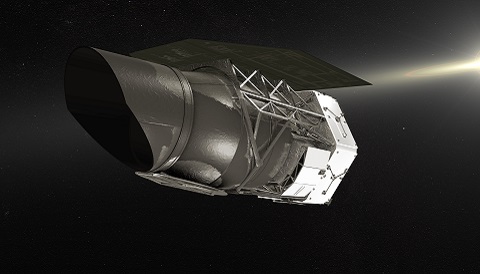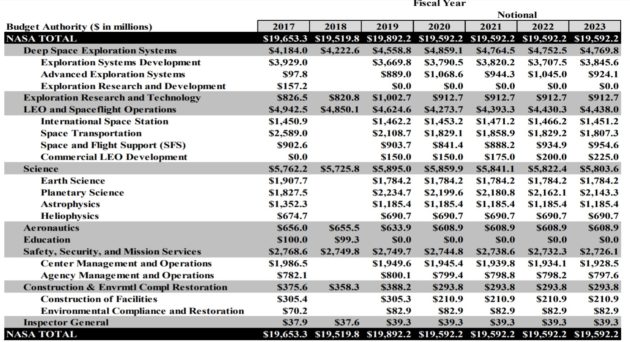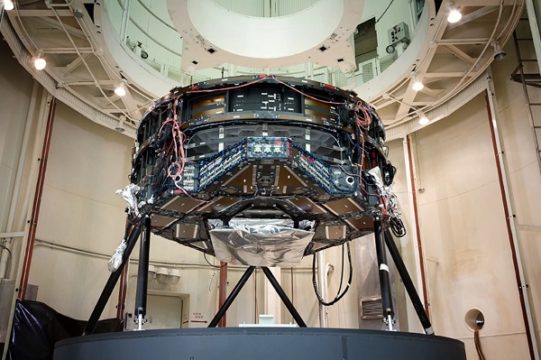The recent budget proposal for NASA dealt a blow to the astronomical community, putting several key missions — including WFIRST, a successor to Hubble — under the financial axe.

NASA
One of NASA's top priority astrophysics missions for the coming decade may never arrive at the launch pad. The 2019 budget proposal for NASA put forth by the current administration calls for the cancellation of the Wide Field Infrared Survey Telescope. WFIRST was planned as the next space observatory in line after the James Webb Space Telescope (JWST), which is scheduled to launch in spring 2019. The 2010 U.S. National Research Council Decadal Survey placed a top priority on the development of WFIRST, which moved from design study to formal development just last year.
Under the proposal, the FY2019 NASA budget would be set at $19.89 billion, up $372 million from the FY2018 budget. However, the proposal would also cap NASA's budget at $19.59 billion for four years starting in 2020 and would not adjust the budget against inflation.
It's important to note that the FY2019 budget request is just a proposal at this stage. The final budget almost always pans out differently than what's requested.

NASA
Crewed exploration would be a big winner in the White House FY19 budget request, which includes NASA's Deep Space Gateway initiative. It also shifts exploration focus yet again, this time to the Moon; the Asteroid Retrieval Mission (ARM) had already been closed out by the FY2018 budget request.
JWST is safe, but the proposal looks to shut down WFIRST in favor of as-yet unnamed “smaller principal investigator-led, astrophysics missions,” White House officials wrote in the budget proposal document released earlier this month. The budget request also states that “these (smaller) missions have a history of providing high scientific impact while training the next generation of scientists and engineers.”
The potential cancellation of WFIRST isn't a complete surprise, as the program was under external review just last year to ensure it could deliver science at a reasonable cost. Findings out this past October cited a mission cost of $3.6 billion, up from its previous price tag of $3.2 billion.
The proposed budget would also cut all funding for NASA's Office of Education, as well as for several Earth-observing missions, including the Plankton, Aerosol, Cloud and ocean Ecosystem observer (PACE), the Climate Absolute Radiance and Refractivity Observer pathfinder (CLARREO) and the Orbiting Carbon Observatory 3 (OCO-3) mission. The Deep Space Climate Observatory (DSCOVR) would continue its mission from its location at the L1 Lagrange point between Earth and the Sun, but the proposal would shutter its Earth-observing instruments.
Planetary sciences will see a slight gain under NASA's overall science budget, from $5.76 to $5.9 billion. However, NASA's acting chief financial officer Andrew Hunter stated in a press call-in that the budget proposal would kill the lander that had tentatively been planned for the Europa Clipper mission, which is set to launch around 2022 to 2025.
The proposal would also look to end government support and funding for the International Space Station after 2025, possibly transitioning the station and low-Earth orbit activities to the commercial sector.
Waiting for WFIRST
Born out of an earlier project named the Joint Dark Energy Mission, the WFIRST mission was named the top goal of the last decadal survey, a document that the astronomical community uses to inform NASA of its priorities for upcoming missions. WFIRST would look for supernovae galaxy clustering, and weak gravitational lensing in order to measure the universe's expansion rate and test theories of how and how quickly the universe is expanding.
The mission received one of its components for free: NASA planned to build the spacecraft around one of two 2.4-meter mirrors donated by the U.S. National Reconnaissance Office. Identical in size to Hubble's mirror (which would result in Hubble-resolution images), the mirror's faster focal ratio would have given WFIRST a much larger field of view: 0.28 square degrees, 100 times greater than Hubble's field of view.
While the mirror was ready-made, funding was still needed to develop instrumentation, namely the telescope's wide-field and coronagraphic imagers. In addition, WFIRST would have flown the first of the next-generation, high-contrast stellar chronographs, capable of directly imaging exoplanets discovered by JWST and the Transiting Exoplanet Survey Satellite, which launches this March.
The American Astronomical Society released a statement addressing the cancellation of WFIRST. “We cannot accept termination of WFIRST, which was the highest-priority space-astronomy mission in the most recent decadal survey,” says AAS President-Elect Megan Donahue (Michigan State University). “And the proposed 10% reduction in NASA's astrophysics budget will cripple U.S. astronomy.”
The statement also highlighted the ominous precedent the proposal sets regarding the validity of the Decadal Survey Program. “These efforts to achieve community consensus on research priorities are vital to ensuring the maximum return on public and private investments in the astronomical sciences,” says AAS Executive Officer Kevin Marvel.

NASA / GSFC / Harris Corporation / TJT Photography
It's certainly a moment of crisis and opportunity for the U.S. space program. Though exciting new missions such as TESS and JWST are set to take to space very soon, we won't see a crewed SLS launch until 2023 or later. Now that the inaugural launch of SpaceX's Falcon Heavy has occurred and we may see a crewed Dragon launch by the end of 2018, some pundits are questioning whether NASA needs SLS at all.
We'll see what the close of the decade brings, as NASA navigates the labyrinth of Capitol Hill.
 3
3









Comments
John
February 23, 2018 at 5:07 pm
Ok, so kill ISS support, and the millions we send to those evil Russian Uber drivers for a lift to it, and redirect those dollars...
You must be logged in to post a comment.
Anthony Barreiro
February 23, 2018 at 6:47 pm
The Goddard video does an excellent job of explaining why WFIRST will be so valuable. It would be simply embarrassing if NASA got a couple of surplus hand-me-down mirrors from a spy agency and couldn't afford to build such a versatile and useful telescope around one of them.
And the proposal that NASA stop gathering any data that might measure global warming and climate change would make Joseph Stalin proud, and George Orwell smile.
Hopefully saner minds in Congress will prevail.
You must be logged in to post a comment.
Stub Mandrel
February 24, 2018 at 3:37 am
As an outside (UK) observer, what I would be writing to my senator about is the line for education.
Absolutely scandalous.
You must be logged in to post a comment.
You must be logged in to post a comment.